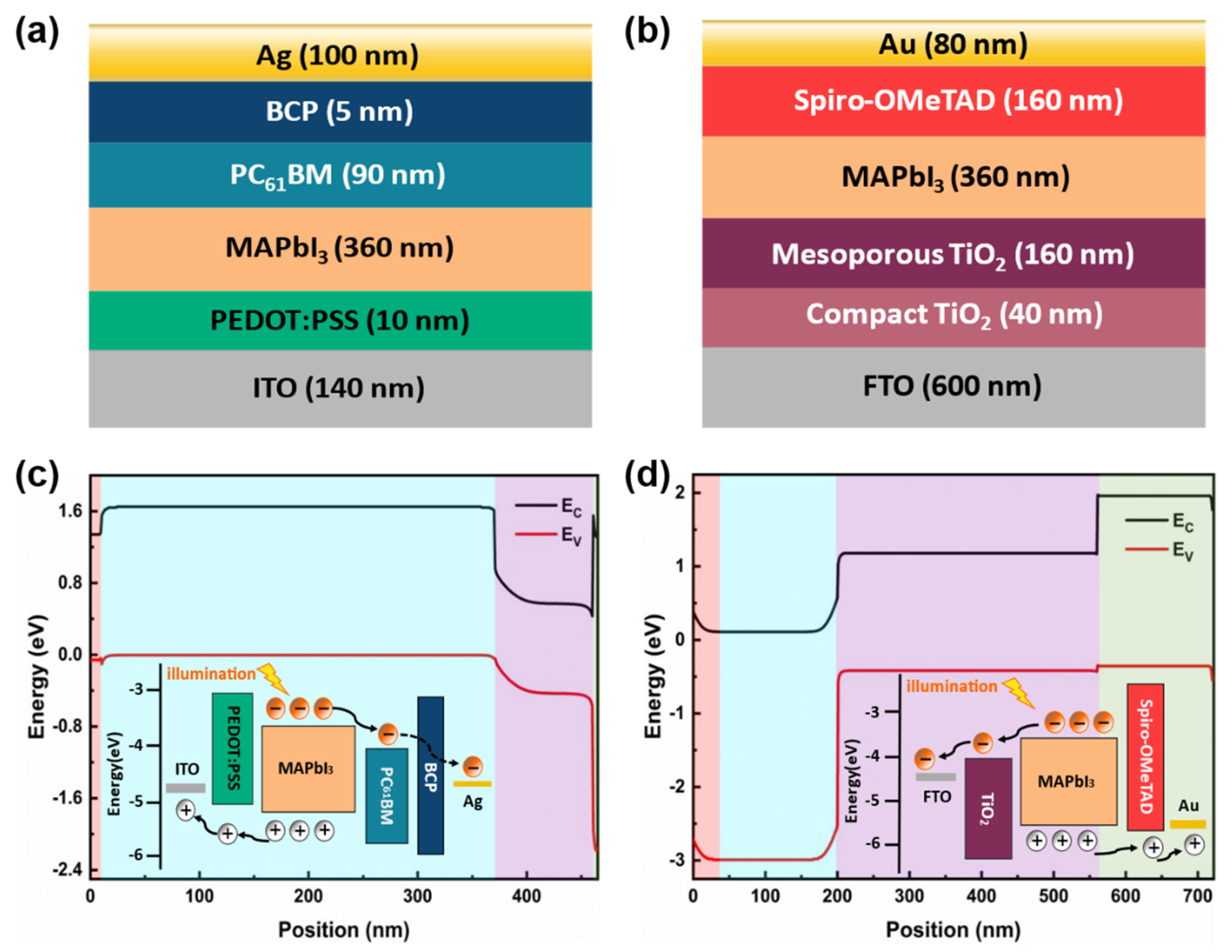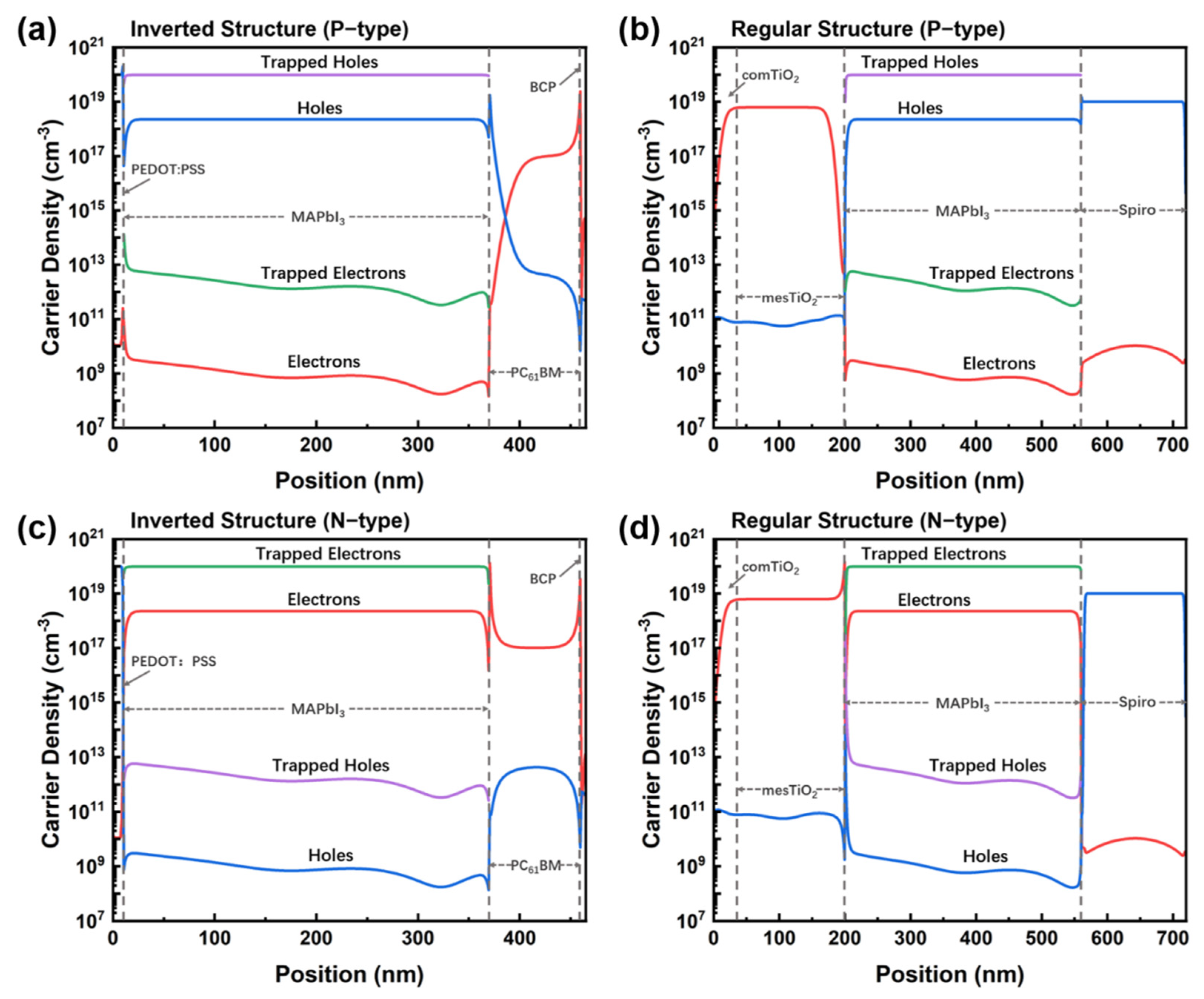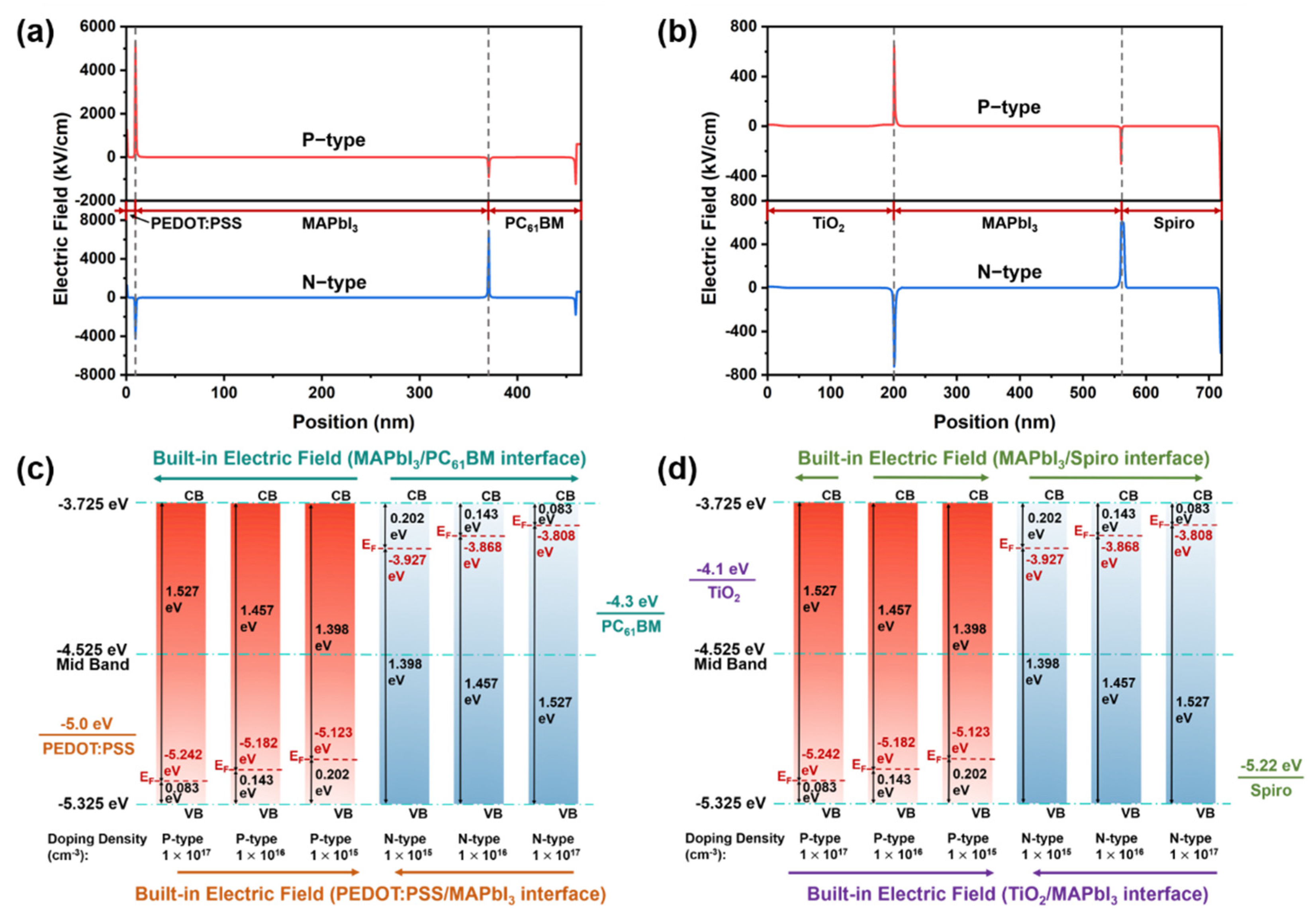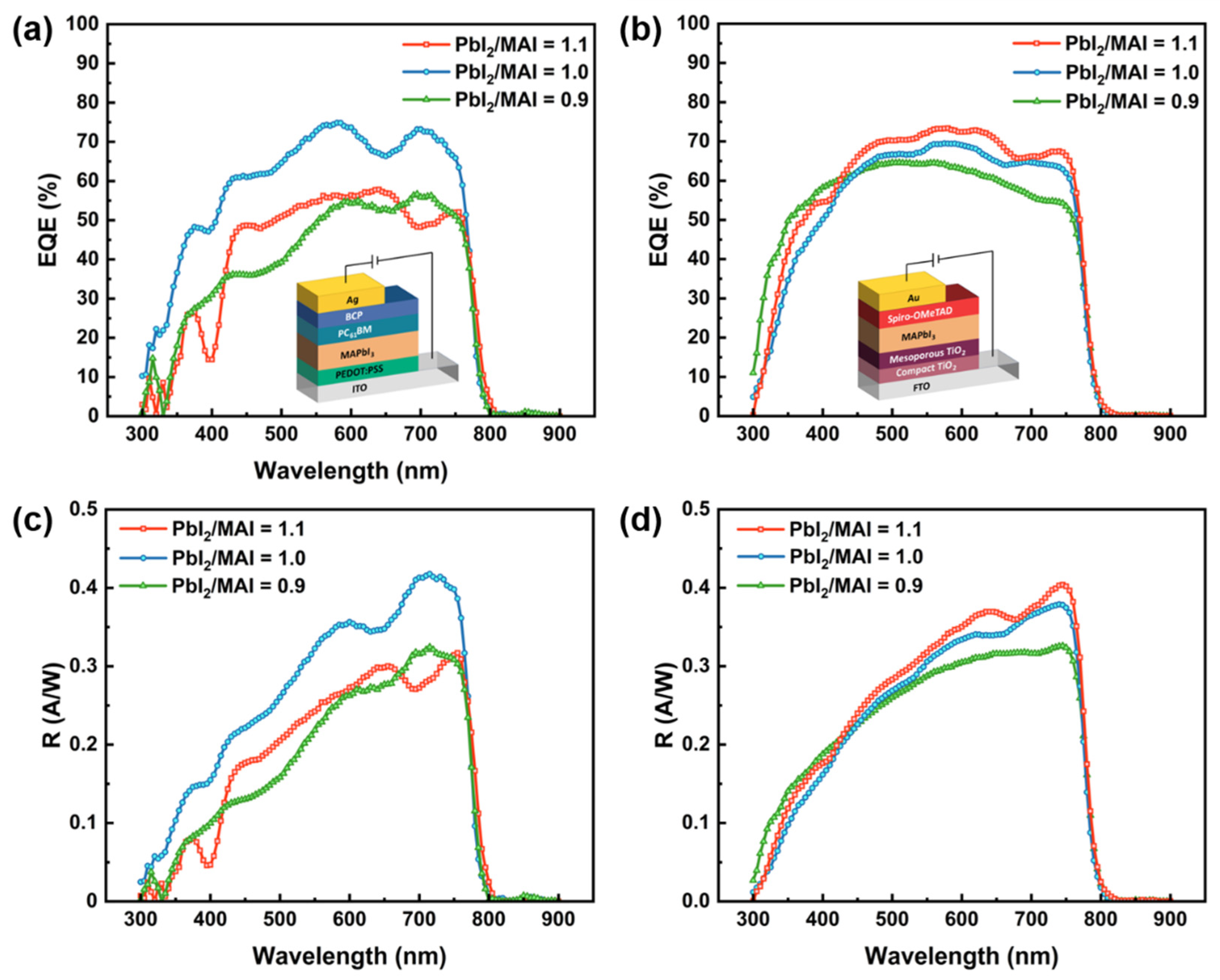Revealing the Hidden Mechanism of Enhanced Responsivity of Doped p-i-n Perovskite Photodiodes via Coupled Opto-Electronic Model
Abstract
:1. Introduction
2. Results and Analysis
2.1. Analysis of the Built-in Electric Fields by the Coupled Opto-Electronic Model
2.2. Doping Type and Density Changing of Perovskite by Precursor Ratio Variation
3. Methods
4. Conclusions
Supplementary Materials
Author Contributions
Funding
Institutional Review Board Statement
Informed Consent Statement
Data Availability Statement
Conflicts of Interest
Sample Availability
References
- Baeg, K.J.; Binda, M.; Natali, D.; Caironi, M.; Noh, Y.Y. Organic Light Detectors: Photodiodes and Phototransistors. Adv. Mater. 2013, 25, 4267–4295. [Google Scholar] [CrossRef] [PubMed]
- Wang, F.; Zou, X.M.; Xu, M.J.; Wang, H.; Wang, H.L.; Guo, H.J.; Guo, J.X.; Wang, P.; Peng, M.; Wang, Z.; et al. Recent Progress on Electrical and Optical Manipulations of Perovskite Photodetectors. Adv. Sci. 2021, 8, 2100569. [Google Scholar] [CrossRef] [PubMed]
- Pan, X.; Zhang, J.; Zhou, H.; Liu, R.; Wu, D.; Wang, R.; Shen, L.; Tao, L.; Zhang, J.; Wang, H. Single-Layer ZnO Hollow Hemispheres Enable High-Performance Self-Powered Perovskite Photodetector for Optical Communication. Nano-Micro Lett. 2021, 13, 70. [Google Scholar] [CrossRef] [PubMed]
- Palaferri, D.; Todorov, Y.; Bigioli, A.; Mottaghizadeh, A.; Gacemi, D.; Calabrese, A.; Vasanelli, A.; Li, L.H.; Davies, A.G.; Linfield, E.H.; et al. Room-Temperature Nine-µm-Wavelength Photodetectors and GHz-Frequency Heterodyne Receivers. Nature 2018, 556, 85–88. [Google Scholar] [CrossRef] [PubMed]
- Jones, A.H.; March, S.D.; Bank, S.R.; Campbell, J.C. Low-Noise High-Temperature AlInAsSb/GaSb Avalanche Photodiodes for 2-μm Applications. Nat. Photonics 2020, 14, 559–563. [Google Scholar] [CrossRef]
- Zhang, R.Z.; Hu, N.Z.; Zhou, H.B.; Zou, K.H.; Su, X.Z.; Zhou, Y.Y.; Song, H.Q.; Pang, K.; Song, H.; Minoofar, A.; et al. Turbulence-Resilient Pilot-Assisted Self-Coherent Free-Space Optical Communications Using Automatic Optoelectronic Mixing of Many Modes. Nat. Photonics 2021, 15, 743–750. [Google Scholar] [CrossRef]
- Maity, S.; Sarkar, K.; Kumar, P. A Progressive Journey into 2D-Chalcogenide/Carbide/Nitride-Based Broadband Photodetectors: Recent Developments and Future Perspectives. J. Mater. Chem. C 2021, 9, 14532–14572. [Google Scholar] [CrossRef]
- Yang, D.; Ma, D. Development of Organic Semiconductor Photodetectors: From Mechanism to Applications. Adv. Opt. Mater. 2019, 7, 1800522. [Google Scholar] [CrossRef]
- Lin, R.X.; Xu, J.; Wei, M.Y.; Wang, Y.R.; Qin, Z.Y.; Liu, Z.; Wu, J.L.; Xiao, K.; Chen, B.; Park, S.M.; et al. All-Perovskite Tandem Solar Cells with Improved Grain Surface Passivation. Nature 2022, 603, 73–78. [Google Scholar] [CrossRef]
- Li, J.; Han, Z.; Gu, Y.; Yu, D.; Liu, J.; Hu, D.; Xu, X.; Zeng, H. Perovskite Single Crystals: Synthesis, Optoelectronic Properties, and Application. Adv. Funct. Mater. 2021, 31, 2008684. [Google Scholar] [CrossRef]
- Brinkmann, K.O.; Becker, T.; Zimmermann, F.; Kreusel, C.; Gahlmann, T.; Theisen, M.; Haeger, T.; Olthof, S.; Tuckmantel, C.; Gunster, M.; et al. Perovskite-Organic Tandem Solar Cells with Indium Oxide Interconnect. Nature 2022, 604, 280–286. [Google Scholar] [CrossRef] [PubMed]
- Ren, H.; Chen, J.D.; Li, Y.Q.; Tang, J.X. Recent Progress in Organic Photodetectors and their Applications. Adv. Sci. 2021, 8, 2002418. [Google Scholar] [CrossRef] [PubMed]
- Ghosh, J.; Giri, P.K. Recent Advances in Perovskite/2D Materials Based Hybrid Photodetectors. J. Phys.-Mater. 2021, 4, 032008. [Google Scholar] [CrossRef]
- Zhang, Y.Q.; Ma, Y.; Wang, Y.X.; Zhang, X.D.; Zuo, C.T.; Shen, L.; Ding, L.M. Lead-Free Perovskite Photodetectors: Progress, Challenges, and Opportunities. Adv. Mater. 2021, 33, 2006691. [Google Scholar] [CrossRef] [PubMed]
- Gu, H.; Chen, S.C.; Zheng, Q.D. Emerging Perovskite Materials with Different Nanostructures for Photodetectors. Adv. Opt. Mater. 2021, 9, 2001637. [Google Scholar] [CrossRef]
- Kim, J.; Kwon, S.M.; Kang, Y.K.; Kim, Y.H.; Lee, M.J.; Han, K.; Facchetti, A.; Kim, M.G.; Park, S.K. A Skin-Like Two-Dimensionally Pixelized Full-Color Quantum Dot Photodetector. Sci. Adv. 2019, 5, eaax8801. [Google Scholar] [CrossRef]
- Liang, F.X.; Jiang, J.J.; Zhao, Y.Z.; Zhang, Z.X.; Wu, D.; Zeng, L.H.; Tsang, Y.H.; Luo, L.B. Fabrication of MAPbBr3 Single Crystal p-n Photodiode and n-p-n Phototriode for Sensitive Light Detection Application. Adv. Funct. Mater. 2020, 30, 2001033. [Google Scholar] [CrossRef]
- Cao, F.R.; Meng, L.X.; Wang, M.; Tian, W.; Li, L. Gradient Energy Band Driven High-Performance Self-Powered Perovskite/CdS Photodetector. Adv. Mater. 2019, 31, 1806725. [Google Scholar] [CrossRef]
- Wu, D.; Li, W.H.; Liu, H.C.; Xiao, X.T.; Shi, K.M.; Tang, H.D.; Shan, C.W.; Wang, K.; Sun, X.W.; Kyaw, A.K.K. Universal Strategy for Improving Perovskite Photodiode Performance: Interfacial Built-In Electric Field Manipulated by Unintentional Doping. Adv. Sci. 2021, 8, 2170120. [Google Scholar] [CrossRef]
- Yu, P.P.; Hu, K.; Chen, H.Y.; Zheng, L.X.; Fang, X.S. Novel p-p Heterojunctions Self-Powered Broadband Photodetectors with Ultrafast Speed and High Responsivity. Adv. Funct. Mater. 2017, 27, 1703166. [Google Scholar] [CrossRef]
- Khaouani, M.; Bencherif, H.; Meddour, A. Boosted Perovskite Photodetector Performance Using Graphene as Transparent Electrode. Trans. Electr. Electron. Mater. 2022, 23, 113–121. [Google Scholar] [CrossRef]
- Zhou, D.; Chen, G.Y.; Fu, S.D.; Zuo, Y.; Yu, Y. Germanium Photodetector with Distributed Absorption Regions. Opt. Express 2020, 28, 19797–19807. [Google Scholar] [CrossRef] [PubMed]
- Chen, L.Y.; Cai, J.X.; Li, J.Z.; Feng, S.P.; Wei, G.D.; Li, W.D. Nanostructured Texturing of CH3NH3PbI3 Perovskite Thin Film on Flexible Substrate for Photodetector Application. Org. Electron. 2019, 71, 284–289. [Google Scholar] [CrossRef]
- Hoq, A.; Panneerselvam, D.M.; Kabir, M.Z. Sensitivity Reduction Mechanisms in Organic Perovskite X-Ray Detectors. J. Mater. Sci. Mater. Electron. 2021, 32, 16824–16830. [Google Scholar] [CrossRef]
- Upadhyaya, A.; Negi, C.M.S.; Yadav, A.; Gupta, S.K.; Verma, A.S. I-V and Impedance Characterization of a Solution Processed Perovskite Based Heterojunction Photodetector. Superlattices Microstruct. 2018, 122, 410–418. [Google Scholar] [CrossRef]
- Li, Y.T.; Gou, G.Y.; Li, L.S.; Tian, H.; Cong, X.; Ju, Z.Y.; Tian, Y.; Geng, X.S.; Tan, P.H.; Yang, Y.; et al. Millimeter-Scale Nonlocal Photo-Sensing Based on Single-Crystal Perovskite Photodetector. Iscience 2018, 7, 110–119. [Google Scholar] [CrossRef]
- Zhang, J.; Liu, J.J. Two-Dimensional Perovskite Sr2Nb3O10 Nanosheets Meet CuZnS Film: Facile Fabrications and Applications for High-Performance Self-Powered UV Photodetectors. J. Alloys Compd. 2022, 908, 164594. [Google Scholar] [CrossRef]
- Liu, S.T.; Liu, X.H.; Zhu, Z.F.; Wang, S.L.; Gu, Y.; Shan, F.K.; Zou, Y.S. Improved Flexible ZnO/CsPbBr3/Graphene UV Photodetectors with Interface Optimization by Solution Process. Mater. Res. Bull. 2020, 130, 110956. [Google Scholar] [CrossRef]
- Feng, X.Q.; He, Z.Y.; Liu, Z.D.; Zhu, W.; Zhao, M.H.; Yang, S.W.; Guo, Q.L.; Chen, D.; Ding, G.Q.; Wang, G. Intact Vertical 3D-0D-2D Carbon-Based p-n Junctions for Use in High-Performance Photodetectors. Adv. Opt. Mater. 2021, 9, 2100387. [Google Scholar] [CrossRef]
- Ahmadi, M.; Wu, T.; Hu, B. A Review on Organic-Inorganic Halide Perovskite Photodetectors: Device Engineering and Fundamental Physics. Adv. Mater. 2017, 29, 1605242. [Google Scholar] [CrossRef]
- Petrovic, J.; Matavulj, P.; Qi, D.F.; Chambers, D.K.; Selmic, S. A Model for the Current-Voltage Characteristics of ITO/PEDOT: PSS/MEH-PPV/Al Photodetectors. IEEE Photonics Technol. Lett. 2008, 20, 348–350. [Google Scholar] [CrossRef]
- Chen, J.; Park, N.G. Causes and Solutions of Recombination in Perovskite Solar Cells. Adv. Mater. 2019, 31, 1803019. [Google Scholar] [CrossRef] [PubMed]
- Xu, W.Z.; Zheng, L.Y.; Zhu, T.; Liu, L.; Gong, X. Bulk Heterojunction Perovskite Solar Cells Incorporated with Zn2SnO4 Nanoparticles as the Electron Acceptors. ACS Appl. Mater. Interfaces 2019, 11, 34020–34029. [Google Scholar] [CrossRef] [PubMed]
- Shi, J.J.; Li, Y.M.; Li, Y.S.; Wu, H.J.; Luo, Y.H.; Li, D.M.; Meng, Q.B. Eliminating the Electric Field Response in a Perovskite Heterojunction Solar Cell to Improve Operational Stability. Sci. Bull. 2021, 66, 536–544. [Google Scholar] [CrossRef]
- Knapp, E.; Häusermann, R.; Schwarzenbach, H.U.; Ruhstaller, B. Numerical Simulation of Charge Transport in Disordered Organic Semiconductor Devices. J. Appl. Phys. 2010, 108, 054504. [Google Scholar] [CrossRef]
- Pisarenko, I.; Ryndin, E. Photodetector with Controlled Relocation of Carrier Density Peaks: Concept and Numerical Simulation. Photonics 2020, 7, 21. [Google Scholar] [CrossRef]
- Pisarenko, I.; Ryndin, E. Drift-Diffusion Simulation of High-Speed Optoelectronic Devices. Electronics 2019, 8, 106. [Google Scholar] [CrossRef]
- Wang, Y.D.; Liu, Y.L.; Cao, S.K.; Wang, J.Z. A Review on Solution-Processed Perovskite/Organic Hybrid Photodetectors. J. Mater. Chem. C 2021, 9, 5302–5322. [Google Scholar] [CrossRef]
- Zhao, Y.; Li, C.L.; Shen, L. Recent Advances on Organic-Inorganic Hybrid Perovskite Photodetectors with Fast Response. Infomat 2019, 1, 164–182. [Google Scholar] [CrossRef]
- Li, L.; Chen, H.Y.; Fang, Z.M.; Meng, X.Y.; Zuo, C.T.; Lv, M.L.; Tian, Y.Z.; Fang, Y.; Xiao, Z.; Shan, C.X.; et al. An Electrically Modulated Single-Color/Dual-Color Imaging Photodetector. Adv. Mater. 2020, 32, 1907257. [Google Scholar] [CrossRef]







Publisher’s Note: MDPI stays neutral with regard to jurisdictional claims in published maps and institutional affiliations. |
© 2022 by the authors. Licensee MDPI, Basel, Switzerland. This article is an open access article distributed under the terms and conditions of the Creative Commons Attribution (CC BY) license (https://creativecommons.org/licenses/by/4.0/).
Share and Cite
Wu, D.; Zhang, H.; Liu, H.; Li, W.; Xiao, X.; Shi, K.; Ye, T.; Sun, J.; Lin, Z.; Liu, J.; et al. Revealing the Hidden Mechanism of Enhanced Responsivity of Doped p-i-n Perovskite Photodiodes via Coupled Opto-Electronic Model. Molecules 2022, 27, 6223. https://doi.org/10.3390/molecules27196223
Wu D, Zhang H, Liu H, Li W, Xiao X, Shi K, Ye T, Sun J, Lin Z, Liu J, et al. Revealing the Hidden Mechanism of Enhanced Responsivity of Doped p-i-n Perovskite Photodiodes via Coupled Opto-Electronic Model. Molecules. 2022; 27(19):6223. https://doi.org/10.3390/molecules27196223
Chicago/Turabian StyleWu, Dan, Hechun Zhang, Haochen Liu, Wenhui Li, Xiangtian Xiao, Kanming Shi, Taikang Ye, Jiayun Sun, Zhaowen Lin, Jing Liu, and et al. 2022. "Revealing the Hidden Mechanism of Enhanced Responsivity of Doped p-i-n Perovskite Photodiodes via Coupled Opto-Electronic Model" Molecules 27, no. 19: 6223. https://doi.org/10.3390/molecules27196223
APA StyleWu, D., Zhang, H., Liu, H., Li, W., Xiao, X., Shi, K., Ye, T., Sun, J., Lin, Z., Liu, J., Qiu, M., Ko Ko Kyaw, A., & Wang, K. (2022). Revealing the Hidden Mechanism of Enhanced Responsivity of Doped p-i-n Perovskite Photodiodes via Coupled Opto-Electronic Model. Molecules, 27(19), 6223. https://doi.org/10.3390/molecules27196223






